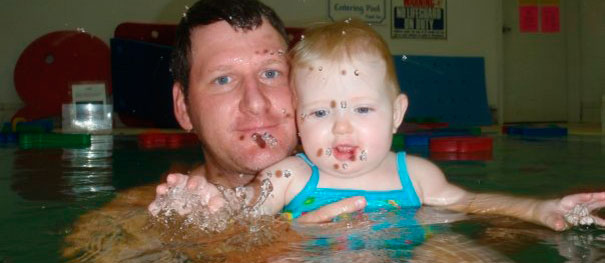
Sitting at poolside during your child’s swimming lesson or at your community pool, you may find yourself people-watching. You may see lots of behaviors exhibited by parents, but what are the ones that are characteristic of good pool parents?
There are definitely some dos and don’ts that apply to the poolside anytime that your child is in or near the water. Here are four of each:
Four Dos:
- Keep eyes and ears on your kids. This is all about your alertness about your child’s whereabouts and activities in and around the pool. Always know where your kids are and what they’re doing. Know the signs of drowning and watch and listen for them. Also be alert to silence when or where there should be activity.
- Bring sunscreen. Regardless of what the sky looks like, have your child use sunscreen when swimming outdoors. Being under the water is not protection. Sunburn in painful and has long-term risks. Always apply sunscreen according to the package directions.
- Pack snacks and water. Your child is surrounded by water while swimming, but he needs to be drinking it too. So supplying water to drink makes sure that your child stays hydrated. This is as true during the winter as in the summer. While your child may not get as hot in the winter, the body is using up energy and needs to be hydrated to re-energize. This is true for healthy snacks as well. Your child’s body needs to replenish to prevent his muscles from cramping and to keep his energy level up so he can enjoy swimming in a healthy way.
- Keep your child in swimming lessons. Your child may have a blast in the water, splashing around and paddling from side to side in the shallows. This doesn’t mean he’s really swimming. Lessons are important to make sure that your child develops this potentially life-saving skill so that he can safely enjoy water activities across his lifetime.
Four Don’ts:
- Walk away. You may want to find a quiet area to catch up on a call. You may even want to run to the drug store next door to pick up your prescription refill. After all, it would only take a minute or two. Things (accomplishing skills and accidents) happen quickly around a pool. And you don’t want to miss any of it.
- Keep your face in your phone. When you’re near the water that your child is in you don’t want to be distracted by anything. Ditto the above note. This is not the time to demonstrate your multi-tasking skills. You can also add that your children will also pick up on the fact that you aren’t engaged in what they’re doing. And this may affect the effort they put into it.
- Allow your child swim alone. The buddy system always applies. Even if your child is waiting for his lessons to start, the place for him is not playing in the water alone. You need to follow the rules established at our pool and have your child wait patiently for his lesson to start.
- Think life jackets are only for boats. Not every child is comfortable enough in the water to paddle around without a life jacket. If the water is deeper than you’re comfortable with keep a life jacket nearby just in case – and don’t hesitate to have him wear it. This is especially important when younger and older children are in the pool together. Younger ones will emulate or follow the older ones.
This is real basic stuff. It may seem trivial at first glance. These are things you know. However, sometimes it’s good to remind ourselves of the things that are basic so we never overlook something that could save a child’s life.


Conversations